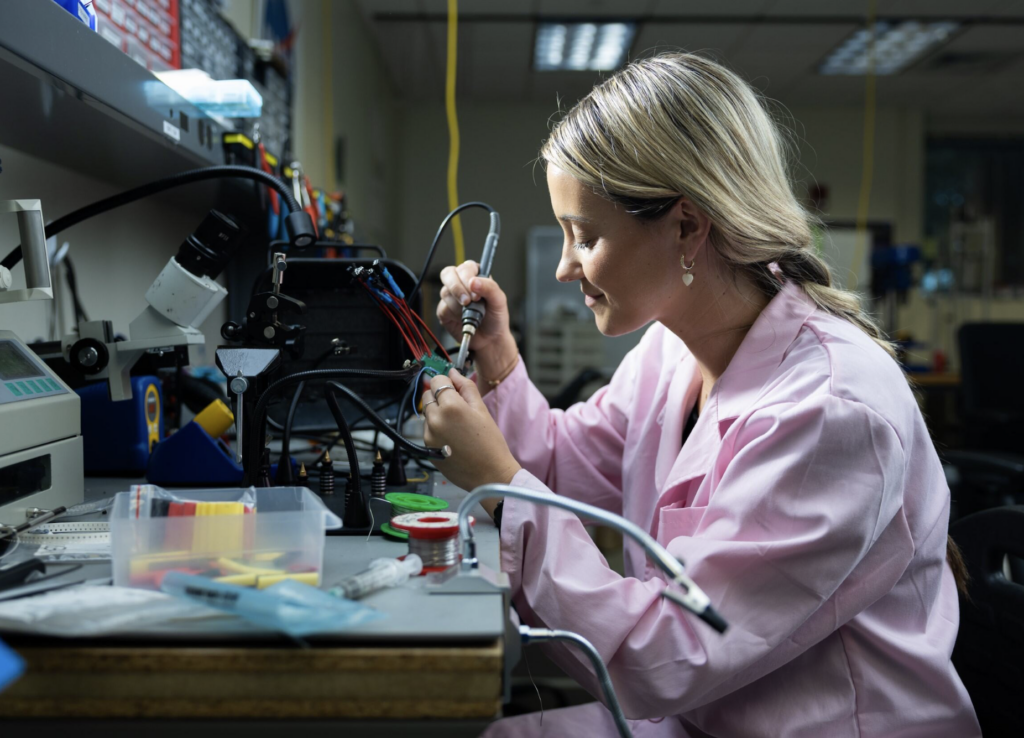EXPERIMENTAL PLANETARY SCIENCES: SMALL BODIES LAB

OUR SMALL BODIES LAB
This lab specializes in studying the mechanical properties of dust particles, including their behavior under various environmental conditions found in the solar system, such as microgravity, vacuum, and temperature extremes. Research includes understanding how dust aggregates form, how particles interact with one another and with surfaces, and their roles in processes like planetary accretion, surface erosion, and the formation of regolith layers. The lab is a collaborative space where part-time undergraduate students play a key role in conducting experiments, analyzing data, and contributing to ongoing projects. They are supported by a large team of undergraduate and graduate researchers who provide additional expertise and mentorship, ensuring a dynamic and educational research environment.

MEET AUDREY DURHAM
As the lab manager and researcher, Audrey oversees all projects conducted in the lab. Her responsibilities include interviewing and hiring new students, managing administrative tasks, and ensuring smooth lab operations. Audrey graduated from Purdue University in 2023 with a degree in Planetary Science, equipping her with a strong foundation in space science to guide the lab’s projects effectively. During her undergraduate studies, her research focused on fluvial surface processes, particularly on Mars. Currently, she is leading her own research project investigating the North Polar Layered Deposits on Mars. This work examines the angle of internal friction and angle of repose in salty-icy Martian mixtures, providing valuable insights into the material properties of these regions. The findings will be critical for future rover missions to Mars’ polar regions. For undergraduate or graduate students interested in joining the lab, please contact Audrey at Audrey.durham@ucf.edu.
OUR ONGOING SMALL BODIES LAB PROJECTS
UNDERSTANDING ICY COLLISIONS IN THE EARLY SOLAR SYSTEM
This ongoing project, led by PhD student Rachel Lowers and supported by several undergraduate students, focuses on prototyping spherical molds of various sizes to create aggregates from simulant. These aggregates range in size from 2 centimeters to 2 millimeters. A key component of this project is a drop tower, designed by mechanical and electrical engineers, which holds two molded aggregates in cups positioned for collision experiments. The electrical engineers developed a custom control board and enclosure, allowing for simple operation—pressing a button releases the aggregates, and their collision is recorded using a GoPro.
The research examines the aggregates’ falling speed, whether they bounce or collide, and their coefficients of restitution. Experiments have been conducted under both normal atmospheric pressure and within a vacuum chamber. Future work involves incorporating a cooling mechanism into the drop tower and aggregate formation process. The goal is to integrate ice into the aggregates, simulating icy collisions in the solar system. To achieve this, ice will be mixed with simulant, and metal molds will be used to maintain low temperatures. A cryogenic cooling system, currently under development, will circulate liquid air through specialized tubing attached to the drop tower to preserve the cold temperatures of the aggregates.
By combining cooled aggregates and low-pressure conditions, this project aims to replicate outer space environments and analyze the dynamics of these simulated collisions.
UNDERSTANDING DUNE MATERIAL ON TITAN
In our Titan project, we developed a larger drop tower to simulate Titan’s gravity. The tower incorporates a counterweight system designed to replicate the moon’s reduced gravitational force during drops. On this drop tower, we use a shear cell, designed and machined by aerospace and mechanical engineering students in the lab. This cell is equipped with two linear actuators, enabling it to shear and compress materials during free fall. We load the cell with various Titan simulants, then initiate the drop with a button. As the cell falls under simulated Titan gravity, it simultaneously shears and compresses the material, allowing us to study its mechanical properties and assess the strength of different simulant compositions. We are nearing the completion of the initial drop experiments and plan to proceed by introducing a cooling system (similar to that used in the aggregate project) to evaluate the impact of temperature on material strength.
Additionally, we are developing a penetrometer to further enhance the Titan project. The penetrometer, inspired by the design of the Huygens probe but significantly smaller, will measure the resistance of the Titan simulants, providing deeper insights into their physical properties.
DRIVE (DROPPING REGOLITH IN VACUUM ENVIRONMENT)
The Drive project combines elements from both the aggregate and Titan projects. It utilizes a drop tower identical to the one used in the aggregate project and a shear cell identical to the one developed for the Titan project. However, this project focuses on asteroid simulants. Instead of Titan simulants, asteroid simulant is loaded into the shear cell, which is then dropped under microgravity conditions within a vacuum chamber.
The goal of Drive is to gain a deeper understanding of the strength and mechanical properties of asteroid materials under simulated space conditions.
MESS (MECHANICAL EXOLITH SPEED OF SOUND PAYLOAD
This payload was flown with Blue Origin’s New Sheppard flight in December of 2023. In this 3D printed payload, it measures the speed of sound in asteroid regolith in a real microgravity environment (since it was sent to space, of course). We had three different compartments filled with different grain sizes of regolith to measure the differences. The payload has returned back to FSI, and we are currently analyzing the results.

HELP US SUPPORT OUR RESEARCHERS IN THEIR PURSUITS
Support groundbreaking space exploration by contributing to the future of scientific discovery. Click here to help fund critical research and advance our understanding of the universe!